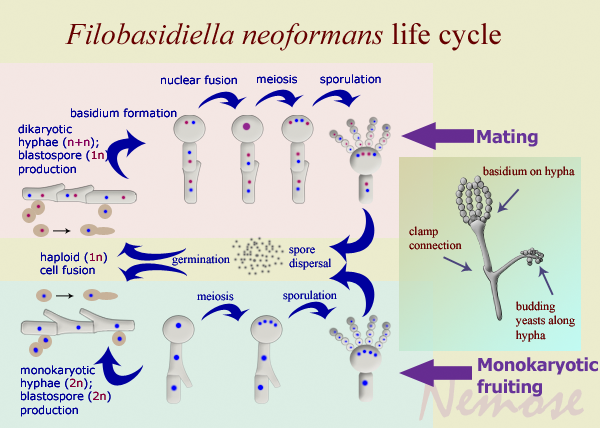Cryptococcus neoformans
General description
Cryptococcus neoformans (anamorph) or Filobasidiella neoformans (teleomorph) is an encapsulated heterobasidiomycetous fungus that usually grows as a yeast and replicates by budding. It is distributed worldwide and is often found in soil contaminated by avian feces.
Disease
F. neoformans is a causative agent of cryptococcosis, also known as Busse-Buschke disease, a disease that ranges from asymptomatic infection of airways to severe meningitis. The most common route of introduction of the infection is inhalation of fungal spores. The crucial factor of the disease outcome is believed to be not the pathogen's virulence but the immune status of the host. The emergence of the HIV virus promoted C. neoformans from a little-known pathogen to a common killer of immunocompromized patients. Cryptococcal meningoencephalitis is considered one of AIDS-defining conditions and is the third most frequent neurological complication in AIDS patients.
Transmission
Inhalation of airborne propagules from the environment is main pathway of infection. The major environmental sources are either soil contaminated with pigeon guano (C. neoformans var. neoformans and var. grubii) or eucalyptus trees and decaying wood (C. neoformans var. gattii - now C. bacillisporus). Cryptococcosis occurs in both animals and humans, but animal-to-animal or human-to-human transmission has not been documented, except for rare examples of iatrogenic (as a result of treatment) transmission. Other than being neurotropic, Cryptococcus can infect or spread to any organ to cause localized infections involving skin, eyes, myocardium, bones, joints, lungs, prostate gland, and urinary tract.
Neurotropism
There are three possible hypotheses that can explain the pathogen's predilection for the Central Nervous System (CNS):
specific neuronal substrates such as dopamine and epinephrine can facilitate fungal growth;
being a privileged tissue site in terms of vigorousness of immune responses, the CNS might provide safer environments for the fungus then other body sites;
specific receptors present on neuronal cells could be more attractive for Cryptococcus cells than other organs during systemic infection.
The fungus has the following essential virulence factors:
Synthesis of the pigment melanin. Melanin protects the fungal cells against oxidative stress, phagocytosis, and antifungal drugs, and also can modify host immune responses.
Development of polysaccaride capsule, which helps the fungus cells to withstand phagocytosis by alveolar macrophages.
Ability to grow at body temperature (37-39°C). The vast majority of fungal species grow optimally between 25 and 35°C and there are only a few fungal species that appear thermotolerant and this physical characteristic is a pre-requisite phenotype for invasive mycoses in a mammalian host. Furthermore, C. neoformans cells can survive in the gastrointestinal tract of birds (~40°C), which in many instance responsible for environmental spread of the pathogen.
Advantages of Cryptococcus neoformans as the model for studies of fungal pathogenesis:
A clinically important human pathogen. It has risen from a rare cause of human infection with less than 300 reported cases before 1955 to a common world-wide pathogen in the immunocompromized populations over the last decades. One study has found that the majotity of adult possess antibody to the fungus, and in New York city most children acquire antibodies to cryptococcal antigens before the age of 10.
A tractable genetic system, availability of various mutants.
Understanding of several virulence phenotypes.
Well-studied pathophysiology.
Robust animal models (rats, mice, and rabbits).
